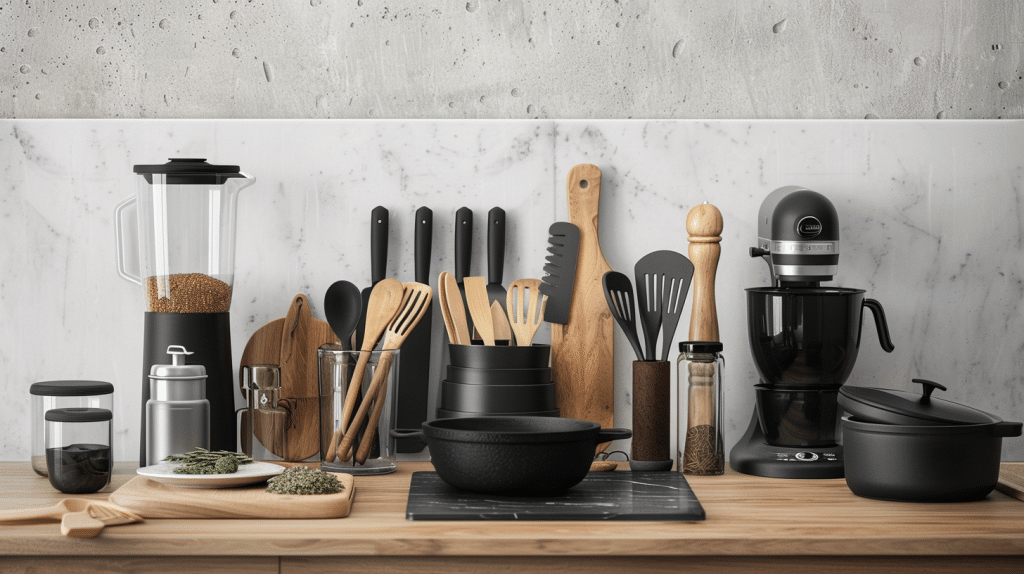Understanding what to sell on Amazon FBA is crucial for success. This service takes care of logistics like storage and shipping, letting you focus on selecting products and marketing.
Consider seasonality in your product choice — related items could be profitable for each season that’s near. Also, think about evergreen products with consistent year-round demand, like home essentials and electronics, as they offer stability.
Want more insights on choosing the right products for Amazon FBA? Keep reading for practical tips and strategies.
Products to Sell on Amazon FBA
1. Eco-Friendly Products

These items are bestsellers due to the increasing consumer preference for sustainable products. They often command higher prices and have strong brand loyalty, contributing to higher profit margins. Additionally, eco-friendly products often have less competition, allowing for greater market share.
A great example is reusable stainless steel straws, which have become a popular alternative to plastic straws. Products like biodegradable phone cases are also gaining traction.
2. Health and Wellness Supplements

This category benefits from high repeat purchase rates and a broad target market. Supplements have high perceived value, which can translate into better profit margins. The wellness trend shows no signs of slowing, ensuring steady demand.
Omega-3 fish oil capsules and whey protein powders are consistently among the best-sellers. Probiotic supplements for gut health are also highly popular.
3. Smart Home Devices

These gadgets appeal to a tech-savvy demographic willing to invest in home convenience and efficiency. They often feature higher price points and innovative features that can justify a premium, leading to higher profits.
Products like the Amazon Echo Dot or the Philips Hue Smart Lightbulb have topped sales charts. Smart thermostats from brands like Nest are also in high demand.
4. Fitness and Outdoor Gear

With a global shift towards health consciousness, these products have a vast market. Many fitness items are lightweight and easy to ship, reducing logistics costs, and they often have high mark-up potentials.
Resistance bands and yoga mats, particularly those with unique features like alignment guides, are perennial best-sellers. Compact and portable workout equipment like jump ropes are also popular.
5. Office Supplies and Equipment

The ongoing remote work trend ensures a steady demand for these products. Items that enhance productivity and comfort can command higher prices, and the market is willing to pay for quality, leading to good profit margins.
Ergonomic office chairs and standing desks have seen a surge in sales. Noise-cancelling headphones from brands like Bose and Sony are also top choices.
6. Pet Products

Pet owners are known for spending generously on their pets. This market has a strong emotional component, driving higher sales. Additionally, pet products often have a broad range, from low-cost items to premium products, catering to diverse consumer segments.
Interactive pet toys, such as treat-dispensing balls, and health-focused products like organic pet food, are consistent best-sellers. Luxury pet beds and grooming tools also perform well.
7. Educational Toys and Games

Parents are increasingly investing in educational development, making this a lucrative market. These products often have a high perceived value, allowing for healthy margins. Plus, the demand for quality, safe, and informative toys is consistent.
Building sets like LEGO and educational electronic toys like Osmo are always in high demand. Science kits and puzzle games that promote STEM skills are also top sellers.
8. Beauty and Personal Care

This market benefits from high brand loyalty and frequent repurchases. Premium beauty and personal care products can command high prices, and innovations in this space can quickly gain popularity, leading to significant profits.
Korean skincare products, like sheet masks, and organic serums have a high sales rate. High-tech beauty tools, such as facial cleansing brushes from brands like Foreo, are also popular.
9. Fashion Accessories

The fashion accessories market allows for high markups, especially for items that are trendy or have a unique selling proposition. The ability to rapidly adapt to fashion trends makes this category particularly profitable.
Sustainable fashion items, like cork-based wallets and watches, are trendy. Smartwatches, especially those with health-tracking features, consistently rank high in sales.
10. Kitchen Gadgets

With an increasing interest in home cooking, kitchen gadgets see consistent demand. Many of these products offer convenience and innovation, which customers are willing to pay a premium for. Additionally, they often have a broad appeal across various demographics.
Air fryers from brands like Ninja and Instant Pot multi-cookers are immensely popular due to their convenience and versatility. High-quality chef’s knives and silicone baking mats are also best-sellers.
These categories are best sellers on Amazon FBA due to their alignment with current consumer trends, potential for high-profit margins, and strong market demand. They offer opportunities for both niche targeting and broad market appeal, making them ideal choices for sellers looking to maximize profitability on Amazon.
Also read:
- What’s the Amazon FBA Success Rate in 2024: Sellers Guide
- [FULL GUIDE 2024] How to Start Amazon FBA with No Money
Product Research and Selection
Comprehensive product research and an informed selection process are important to your success in selling on Amazon. These steps help you uncover profitable products to sell, manage Amazon FBA fees, and navigate the competitive landscape effectively.
Using Analytical Tools
Using the right analytical tools is crucial to dissect the vast Amazon marketplace. Begin by employing a product database to filter through thousands of products quickly.
By using keyword scout tools, you can discover what potential customers are searching for, and identify trends and demands within your chosen niche. The data gleaned should encompass estimated sales, revenue, and Amazon FBA fees, enabling you to forecast profitability accurately.
Sourcing and Selecting Products
Private label products offer you the benefit of branding and control over margins, while wholesale and retail arbitrage can be less costly upfront, allowing for a diverse inventory. Consider these sourcing strategies:
- Private Label: Ideal for establishing your brand, but requires significant research and investment.
- Wholesale: Purchasing bulk products to sell under the original brand name.
- Retail Arbitrage: Buying discounted products from retailers to resell on Amazon.
Careful supplier research is fundamental to finding high-quality products at a cost that allows for a profitable selling price after accounting for Amazon FBA fees.
Best Practices for Selling on Amazon
When selecting the best products to sell, it’s imperative to:
- Identify a Niche: A well-defined niche can reduce competition and establish your foothold in the market.
- Evaluate Demand and Competition: Assess the demand for potential products while analyzing the competitive landscape.
- Consider Profit Margins: Account for all costs including product costs, shipping, promotions, and Amazon FBA fees, to ensure a desirable profit margin.
By following these guidelines, you position yourself for a greater likelihood of achieving success on Amazon. Remember to stay informed on marketplace trends and adjust your strategies as needed to continue finding and selling profitable products.
Building an Amazon FBA Business
When building an Amazon FBA business, understanding the fulfillment process, effectively listing your products, and grasping the fee structure are foundational elements for success.
Amazon FBA Overview
Fulfillment by Amazon (FBA) allows you as a seller to store your products in Amazon’s fulfillment centers. Here is how the FBA process typically unfolds:
- You ship your products to an Amazon fulfillment center.
- Amazon manages inventory and fulfills orders placed on its platform.
- Delivery: Amazon handles packing, shipping, and customer service for these orders.
Logistics and Fulfillment
Under FBA, inventory storage is critical. Amazon provides resources to help manage your inventory within their fulfillment centers. It’s important to understand various FBA fees:
- Fulfillment Fee: This covers picking, packing, shipping, customer service, and returns.
- Monthly Storage Fee: Charged for space your inventory occupies.
- Long-Term Storage Fee: Applied to items in fulfillment centers for extended periods.
- Removal Order Fees: Charged if you decide to have inventory returned or disposed of.
Using multi-channel fulfillment, you can also fulfill orders from sales channels other than Amazon.
Product Listing Essentials
Effective product listings are essential for FBA success:
- Create Product Listings: Use Amazon’s catalog system to add your items.
- Bullet Points and Description: Clearly outline product features and benefits.
- Inventory Management: Monitor stock levels to keep listings up-to-date.
Strategic Pricing and Fees
Your selling price must cover product costs, Amazon referral fees, and other FBA fees to maintain profitability. Be strategic:
- Referral Fee: Generally a percentage of the selling price, varies by category.
- Understand how changing your price affects FBA fees and your bottom line.
By adhering to these principles, you’ll position your FBA business for potential success on Amazon’s competitive marketplace.
Promotion and Customer Engagement
Promoting your products on Amazon FBA and engaging with customers can significantly increase your sales and competitiveness. Successful sellers leverage both effective marketing strategies and exceptional customer service to stand out in a crowded marketplace.
Marketing Your Products
To drive sales on Amazon FBA, you must understand content marketing and how to make your listings appealing. Use Amazon Seller Central to access tools that enhance your product’s visibility. Key steps include:
- Optimizing Product Listings: Use high-quality images and keyword-rich descriptions.
- Advertising: Invest in Amazon’s advertising solutions such as Sponsored Products to win the Buy Box, which can dramatically increase your sales.
- Promotions: Run discounts and deals, particularly appealing to Prime members, to spur interest and purchases.
Customer Service as a Differentiator
Your level of customer service can set you apart from the competition. Prioritize:
- Prompt Responses: Quickly answer customer inquiries to provide a personalized service.
- Problem Resolution: Efficiently address issues to sustain customer loyalty and positive reviews, which are crucial for success on Amazon.
Understanding Amazon’s Platform
Understanding how to use Amazon’s platform effectively can help you increase sales. You should:
- Leverage Analytics: Utilize the reports and analytics in your Amazon Seller Central account to make informed decisions about inventory and marketing strategies.
- Review Policies: Stay informed about restricted products by regularly checking the list of products you can’t sell on Amazon.
- Stay Organized: Maintain an organized approach to managing your seller account, inventory, and customer interactions.
Also read: What Can I Sell on Amazon Without Approval in 2024?
By focusing on robust marketing, superior customer service, and using Amazon’s platform to its fullest, you position yourself for success in the competitive world of Amazon FBA.
Growing and Sustaining Your Business
To succeed long-term on Amazon FBA, it’s crucial to not only focus on initial sales but also on strategies that help grow and sustain your business. Balancing the ebb and flow of demand while keeping a close eye on performance data can guide your decision-making.
Optimizing for Seasonality
Seasonal shifts significantly influence what sells on Amazon. For instance, during holidays, relevant items may see a surge. Manage your inventory based on:
- Past sales data: Identify peak periods and stock up accordingly.
- Current trends: Stay current on what’s in demand and adjust quickly.
Plan promotions and deals to capitalize on high seasons, ensuring you have processes in place for efficient returns processing.
Analyzing Performance Metrics
Watch your metrics closely as they are indicators of your business health. On Amazon, important metrics include:
- Conversion rates: The percentage of visitors making a purchase.
- Customer feedback scores: Gauge satisfaction and service quality.
- Return rates: High rates may indicate product issues.
Use this data to experiment with different strategies and refine your approach. Regular analysis can transform insights into actionable recommendations aimed at success.
Continual Learning and Adaptation
The market is dynamic, and staying competitive means never stopping learning. Be an expert in your niche and adapt by:
- Keeping up with Amazon’s evolving platform and policies.
- Engaging with communities and resources for online business owners.
Embrace change and pivot your strategies where necessary to maintain and grow your Amazon FBA business. Remember that continual learning and adaptation are cornerstones of a sustainable and successful enterprise.
Conclusion on What to Sell on Amazon FBA
Finding the right products to sell on Amazon FBA in 2024 means picking items that are in demand and profitable. Choose from a variety of best-sellers like eco-friendly goods and tech gadgets, making sure they can earn you good profits.
By doing this, sellers can take advantage of Amazon’s large customer reach and helpful services. Smart product selection and effective marketing make Amazon FBA a great opportunity for both new and seasoned sellers to succeed in the online market.
Frequently Asked Questions About What to Sell on Amazon FBA
How many items do you need to start on Amazon FBA?
You can start selling on Amazon FBA with just one product. The focus should be on the demand, quality, and profitability of the product rather than the quantity of items in your inventory.
Can you make a living off FBA?
Making a living off Amazon FBA is possible with the right strategy, product selection, and commitment. Income varies among sellers; some earn substantial amounts, while others use it for supplemental income.
What is the most profitable product to sell on Amazon?
The most profitable product on Amazon changes with market trends and consumer demands. Products with high demand, low competition, and solid profit margins, such as niche health supplements or unique tech gadgets, are generally more profitable.
Do I have to pay to sell on Amazon?
Yes, selling on Amazon requires payment. There are two seller account types: Individual, costing $0.99 per item sold, and Professional at $39.99 per month. Additional fees include Amazon FBA fees, referral fees, and possibly shipping fees. These should be considered when pricing products.
